Starting at the nose and working toward the stern of the ship, the foremost point is the Disruptor Beam Cannon. Like all weapons of its type, it fires a beam of alternating protons and electrons, playing havoc with the electrical system of any ship unfortunate enough to be on the business end of it.
It has very limited capacity to aim and is limited to within a 10 degree arc in the front of the ship. This weapon takes up considerable room, making it necessary to move the first deck back to 100 meters from the front of the ship.
To further isolate the dangerous beam generators from the Challenger's sensitive computer system, the front of the ship has a flared out region in front of the main hull. This slightly conical shaped region is also home to the ships rocket battery launch tubes and the advanced astrogation equipment.
The launch tubes are placed in a ring shaped structure that can rotate around to face in any direction, with the launch tubes at approximately 30 degrees angle from forward facing. As the rockets fired have their own guidance systems, exact aiming during launch is not critical, but the rough aim ensures that the rockets won't have to use up too much fuel changing course drastically.
It is in this region that the forward radar array and long range navigational telescopes are located. The energy sensors are also located here, naturally well isolated from the Disruptor cannon generators. (Although they are prone to interference within 30 seconds of firing the disruptor cannon due to residual proton fields, but these dissipate rapidly)
| The nose cone is home to a new and powerful weapon in the RAM arsenal against the fight for Earth's freedom - the Plasma Cannon. Essentially a focused nuclear fusion engine, the plasma cannon is very potent, capable of annihilating smaller ships in one shot. Fortunately, it has a very limited capability to aim, only being able to fire straight ahead. |
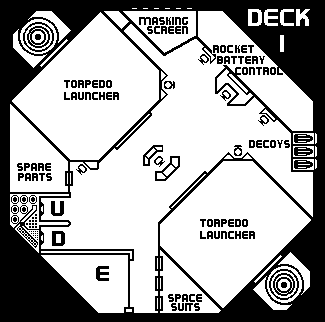
Behind this forward weapons housing lies Deck One, the Upper Gunnery Deck. This is home to the torpedo launchers as well as the rocket battery gunnery station. From his station along the wall opposite the elevator, the rocket battery control officer selects the targets for the ship's eight rocket salvoes.
Although less powerful than the torpedoes, the rockets are harder to intercept and capable of defensive fire. In the center of the deck, sits the Torpedo Launch Officer, surrounded by two consoles of controls. Although the Challenger is equipped with only four torpedoes, they are among the most powerful destructive weapons in the ships arsenal. The explosive power comes from a nuclear warhead in each torpedo. Even in space, the blast radius is sufficient to cause massive hull damage to enemy vessels they strike.
Also located on that deck are the decoys. These three small rockets are equipped with electronic emissions gear that makes their radar images look just like the Challenger's. Their launch is controlled either from the bridge deck, the defensive systems deck, or the small console nearby.
The masking screen is also placed here, for a last ditch escape or laser defense. This too is controlled from the same areas as the decoys. Finally, there are the spacesuit lockers, a spare parts storage room, and the ever present elevator shaft and ladder wells, as well as the wire bundles and life support pipes and ducts that connect all decks. One ladder well is labeled "up" and the other is, of course, for those descending, to avoid unnecessary headaches from untimely collisions between crewmen in a hurry.
| The torpedoes are special weapons. Although missiles, they have a far longer range, and a movement rate of 10. The gunner must retarget the intended target each round, or let the torpedo automatically follow its prey. Its automatic THAC0 is 14. The maximum number of units a torpedo can travel, is 40. If it has not hit a target yet, it will be dead in space, and drift off the map at the heading it last followed. |

On Deck Two lies the hub of all activity on the Starship, the Bridge. It is from here that the Captain commands the ship and all major decisions are made. Many of the work stations face the main viewscreen, mounted on one wall, and others have separate screens at their consoles to monitor their respective fields.
The ship's main helm controls are here as well as disruptor cannon gunnery and astrogation, as they must work closely with the pilot. There are also stations for engineering, ECM jamming, defense control, communications, sensor analysis, security, and life support. In short, the Captain can learn the status of any system on the ship in short order. The Captain's quarters are just behind the bridge.
This deck is also home to one of the most advanced computers ever built. It has access to any program at the most advanced level (level 6) and can make billions of computations per microsecond. It is accessed from the bridge and has many crawlways through it for repairs. Along the corridor to the bridge are more banks of astrogation gear to supplement the equipment in the nose. There is also a spacesuit locker and a security console always manned by at least two security personnel to limit access to the bridge. The bridge is further protected by the spiraling corridor used to get there.
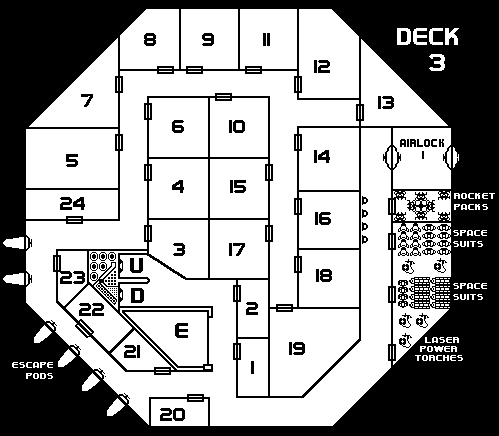
Below the bridge deck is Deck Three, officer and family housing. The term family is used loosely and normally only applies to married couples. The risks of the mission are such that carrying children was thought most unwise. These quarters are for officers or married enlisted personnel and are slightly more spacious than those on deck ten.
This deck also has one of the six main airlocks on the Challenger. It also has a spacesuit locker, five laser power torches (LPTs), and eight rocket packs for EVA activities. There are also six escape pods on this deck.
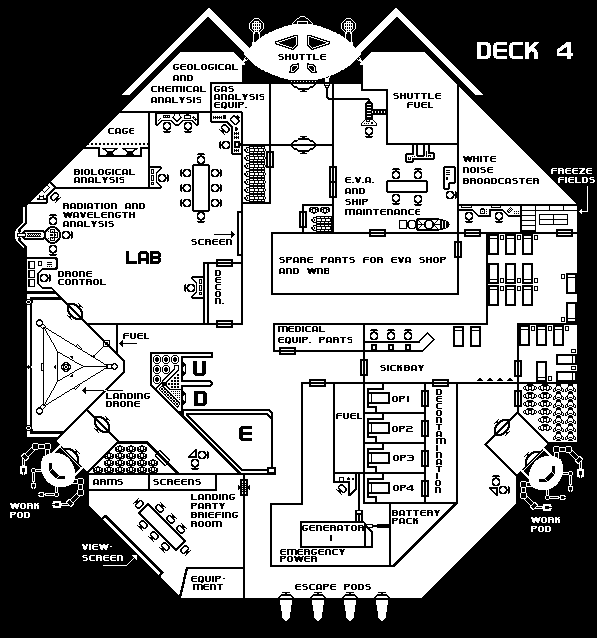
Deck Four is what really separates the Challenger from other heavy cruisers, (and for that matter, all UPF warships) the Science and Medical Deck. Due to its role as an exploration vessel as well as a combat one, the Challenger was built with the capability to fill in for a civilian scientific research ship.
With this in mind, it was equipped with a fully functional scientific laboratory with gas, chemical, geological, and even biological scanners. It also has a sophisticated radiation and wavelength analysis telescope that is mounted by the ship's only porthole. (skin sensors, cameras, radar, and energy sensors are far more useful than portholes in space anyway)
The lab has a full staff of scientists and a decontamination chamber at its entrance to avoid allowing biological hazards to escape from the room in case of an accident while working with some new virus or bacteria found on an away mission.
Next to the Lab is the launch bay for the Landing Drone. Built to soft land on another world from orbit, and return from any world with a gravity of less than 1.2 G's, it is an advanced piece of equipment for unmanned reconnaissance. The Challenger carries an extra fuel tank for refueling its rocket at least twice.
The Challenger's shuttlecraft also docks on this deck, and also has its own spare fuel supply. Like the Landing Drone, the Shuttlecraft can be refueled twice, assuming both landings were at planets with 1G of gravity.
There is also an EVA and shuttlecraft maintenance section nearby. This section is in charge of keeping all rocket packs, space cars, workpods, escape pods, lifeboats, and of course the Shuttlecraft, operational and in top shape.
Beside the shop is the White Noise Broadcaster. This is a more compact version of the WNB mounted on the Battleships and spacestations. It is far more capable than the WNB found on most ships and was deemed necessary by fleet command due to the Challenger's mission. The ability to jam enemy transmissions may well prove critical to the ship's survival.
While in use, the WNB extends a number of antennas which aid in the broadcasting strength.
Next to the WNB is the advanced Medical Sickbay. With twenty beds and four operating rooms, there are few emergencies that the sickbay isn't equipped to handle. Six of the beds are in an isolation ward, and the others are in an open area nearby. The operating rooms are kept sterile by a decontamination chamber between the sickbay and operating rooms. For the cases that no one can handle, or if the operating rooms are backed up due to heavy casualties, there are twelve freeze fields adjacent to the sickbay.
Near the sickbay are the Battery Packs and emergency generator. The battery packs can maintain Medical bay power for eighty hours and both minimal life support and medical bay power for 20 hours with a full crew load, considerably longer if the crews' numbers are reduced due to casualties. In addition, the Emergency Generator can run on its fuel supply for five solar days while recharging the battery packs. In a pinch, the generator can alternate between charging the packs and shutting down until the battery packs are once again drained. Using this system, power fluctuations can be problematic, but the minimal power for the vital systems can be maintained for an extra solar day.
Deck four also has a special briefing room for landing party preparation, where the group would be given maps of the area if available and told mission objectives and abort conditions. There are weapons and defensive screens stored there as well as portable scientific gear and toolkits.
Because of this, the door is one of three aboard the ship that is a security door. (the others being the door to the Captains' quarters and the main security room)
Finally, this deck is home to two workpods and four escape pods. The portals to the workpods and shuttlecraft double as additional airlocks while the pods or shuttle are away. The workpods sit in semi-recessed areas of the hull, like the shuttle.
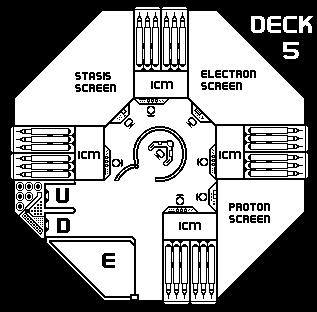
On Deck Five, the ship's defensive systems are located and coordinated by the Defensive Systems officer. He sits in a spherical work station called a virtual reality chamber that, once he is enclosed in it, offers a 360 degree by 360 degree field of view. This data is displayed holographically on the walls of the sphere, with all incoming rockets and torpedoes highlighted and displayed . This also gives him a tactical overview of the situation so he can choose the best screen or ICM salvo for defense.
The orders for screen activation and launch of the ICM salvos are usually given by the Captain, but if the communications systems are down, the Defense Systems officer is free to use his best judgment. The Defense systems officer selects the targets for the Interceptor Missiles and determines which missile cells to launch, and he can correct the missiles' courses while the missiles are still in flight.
The ICM missiles are divided into "cells" of nine missiles each. Three of these cells are considered a full salvo, thus consisting of twenty-seven missiles. The Challenger carries eight of these salvos, providing and effective defense against enemy warheads. Around the VR station are work consoles for monitoring screen status and output, and manual activation in case of damage to remote controls. This deck is also equipped with every modern defensive screen known to the UPF. Lastly there is also a spacesuit locker near the elevator and ladder wells on this deck.
| The anti-missile missiles can disrupt up to 27 missile attacks each round for eight rounds, provided the tactical officer passes a Battle Tactics roll, based on the number of missiles. 1-5 is Easy, 6-12 is Average, 13-20 is Hard, and 21-27 is Difficult. |

The next deck, Deck Six, is the Security and EVA deck. This deck has a built in bay for the ship's launches. The Challenger has two four passenger launches and a single ten passenger launch.
The bay has twin fuel tanks for the reaction thrusters common to both the launches and the portable rocket packs. An airlock separates the EVA bay from the rest of the deck. Directly across from the bay is the EVA briefing and equipment room.
One of the main airlocks from the ship is located in this room. All routine EVA trips leave from this airlock as it is the most centrally located. The main security office is on this deck as well, where security officers can react to boarders on any deck with very short notice due to the centralized location. The security section has all arms and personal defensive screens and suits and, if necessary, can outfit half the crew with full combat gear.
The security stations there can monitor any room and hull skin sensors. If any unauthorized access is made to any security door or airlock, a security team can be dispatched immediately. All security personnel are fully trained in boarding enemy vessels, ground assault, and close quarters combat, both armed and unarmed. Finally this deck has three Lifeboats.
These lifeboats can evacuate up to twenty crew if needed, and can soft land on planets with gravities of up to one point five G's. With maximum crew, they can maintain life support for up to thirty hours.
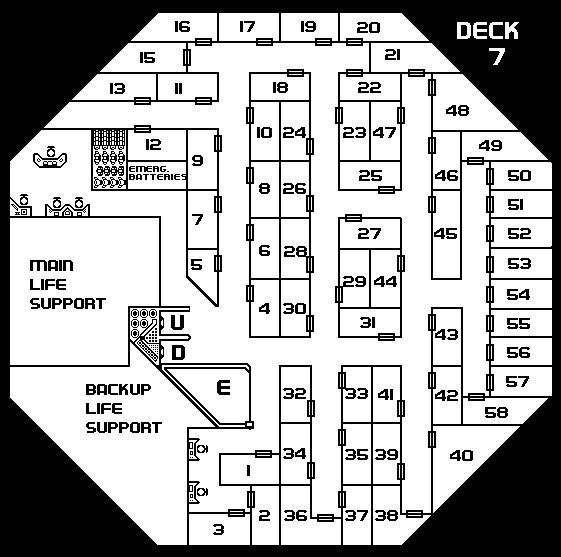
Deck Seven is another crew's quarters deck, but these are less spacious than those on deck three. Housing mostly enlisted personnel, these quarters are still quite private and better than those found on most spacefleet vessels, or for that matter, civilian spacecraft.
The most vital sections aboard the Challenger are undoubtedly the ships powerful life support units. Each of these units have the capability to purify the air, recycle the liquid waste, and warm or cool the interior of the ship as needed. Alone, each unit can support over one hundred fifty beings, far more than the ship's normal crew complement, but they can be operated at the same time if the Challenger needs to take on many passengers due to a rescue mission or evacuation of a colony or space station.
Due to the dangers of explosive decompression and loss of breathable atmosphere from combat hull damage, all air can be pumped into compression tanks in main life support after all crew are able to change into their spacesuits. There are lockers on most decks so that the on-duty crew need not venture far from their posts during what would probably be a crisis situation with combat imminent. Once past the danger, the hull would be repressurised and the crew could store the spacesuits once more.
The crew stations here are used to monitor the life support systems and emergency battery pack power for problems. The battery packs here can power a life support unit for eight solar days.
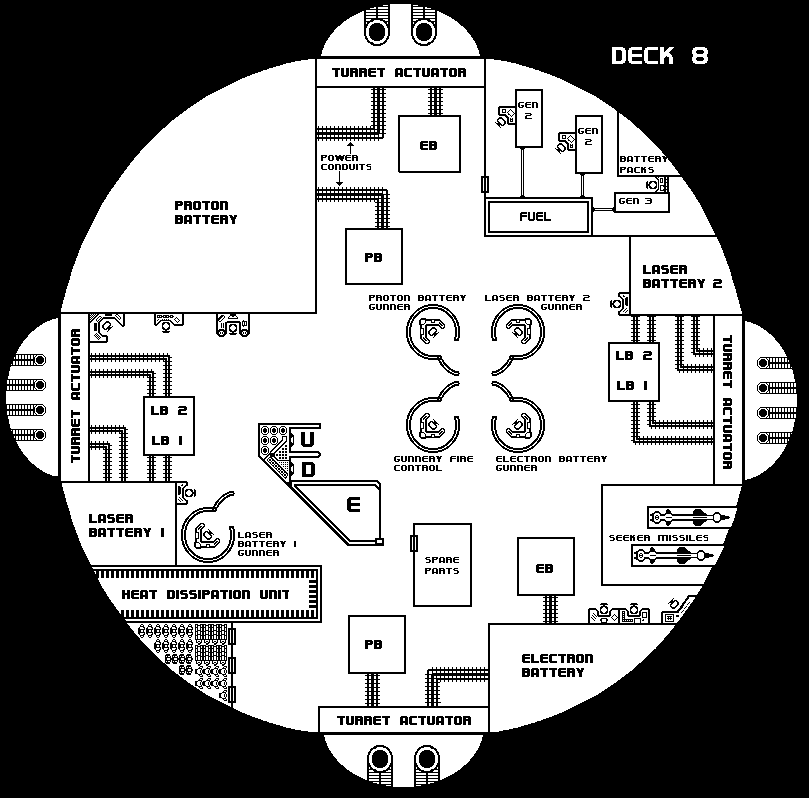
Deck Eight is situated at the widest point of the Challenger's hull. From this point, the four weapon turrets can combine their fields of fire to aim at any point around the Cruiser. The firepower of this deck consists of two laser batteries, an Electron battery, and a Proton battery.
The beam generators are located along the four corners of this deck, with massive three foot diameter power conduits connecting the generators to two turrets on opposite sides of the hull. The turrets along the sides of the ship have four barrels each and are the focusing arrays for the twin laser batteries, two barrels per battery. Along the other sides' turrets are the two barrels for the Electron Battery and the Proton Battery. These barrels are larger than those of the laser batteries.
To some it would seem that placing all batteries on the same deck was tantamount to putting all their eggs in one basket, but the four batteries are widely separated on that deck, and so one hit is unlikely to destroy more than one battery.
The power conduits enter columns near each turret and pass across the deck between decks eight and seven. The four gunners sit in Virtual reality chambers like the Defense Systems officer. In addition there is a chamber for the Gunnery Control Officer. His job is to coordinate fire from the batteries and assign target to the four gunners working nearby. His console can take over for any of the others in case of damage to one of the main gunners' pods. Lastly, he's in charge of launching and activating the two Seeker Missiles. If not activated during the fight, they can later be retrieved by a workpod and placed back in their launchers.
This deck has three power generators and another set of battery packs for use with either life support or powering up Laser Battery One. This maintains offensive power even when the engine power has failed. Without the main cooling system working, all excess heat build up is shunted out through the massive Heat dissipation unit nearby. Although this makes the deck uncomfortably hot after a few firings, it keeps the circuitry cool enough to prevent thermal runaway. This isn't necessary while engine power is working because it powers the main heat sinks, venting the heat harmlessly into space.
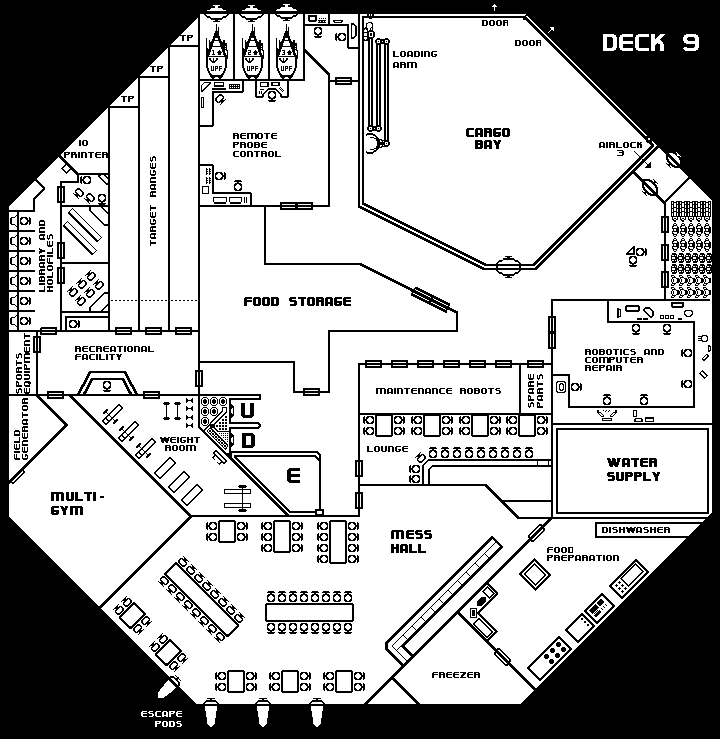
Most of the space on Deck Nine is devoted to storage of the supplies needed for the long journeys for which the Challenger was designed. There is a large cargo bay with a loading arm and massive doors that open into space. This bay is sealed off from the rest of the ship by a single airtight door. The cargomasters' office is located to the left of the bay. The controls for the loading arm are located in his office as well as supply inventory lists.
Across from the main cargo bay is a food storage locker. Environmental controls here allow it to be used as a freezer if needed. The main water storage tank is nearby. Replenished by the liquid waste recycling in the Life Support units, this tank is more than adequate for most circumstances.
The Robotics and Computer repair shop and maintenance robot storage room were also built into this level, where there was enough room for its diagnostic equipment and robot parabattery recharging station. The maintenance robots are all level four maintenance robots, but can be used by the damage control crews to transport heavy parts and plates from place to place aboard ship.
Between the shop and the cargo bay, airlock three and its accompanying spacesuit locker provide an exit for those crew assigned to help with loading of supplies.
These supplies are put to use in the mess hall across from the cargo bay. In its food preparation center, the ship's cooks work their "magic" with the dehydrated, compacted foods from the supply locker. There is no proof to the vicious rumor that the four escape pods accessed from the mess hall were placed there due to the quality of the food prepared there. The mess hall is more than a place to eat. It and its accompanying lounge are meeting places for off duty crew and all briefings with the majority of the crew are held in the mess hall as it's the only single room large enough to comfortably hold them.
On long voyages, nothing relieves stress like an hour in the weight room, multi gym, library, holofilm cinema, or target ranges. They're all in the recreation facility on this deck. The weight room has powerful electromagnets to keep the weights in place during weightless or high-G maneuvers. Weight benches are designed for use for all races.
Beside the weight room is the Multi Gym. Due to the limited space aboard the Challenger, the gym is equipped with a field generator to change the shape to anything from Racquetball to Vrusk K'lab'ak. Sports equipment is stored in a locker near the entrance.
The Holofilm and library section is popular with crew in the mood for more sedentary activities. Although the latest Holofilms are hard to get, there is a large library of the older films. The library has an IO printing machine so that crew can get a hard copy version of what they find on their computer searches. Some of the rooms are large enough for a group of friends to meet and relax together with their favorite shows. (mostly reruns)
For both recreation and training, there are three target ranges. These have target projectors at the far end and are set up with inertia, sonic, albedo, and gauss screens so that any weapon may be practiced with. The screens absorb most of the blast from the weapons and what little gets through, the steel walls stop. The targets that can be displayed can vary widely but usually consist of Sathar troops. (or perhaps an infamous celebrity)
The last item squeezed onto this deck is the remote probe control center. These probes are more expendable than the landing drone, but quite useful for reconnaissance of dangerous spacial phenomena. They are equipped with radar, energy sensors, telescopic cameras, gas samplers, thermographic imagers, radiation detectors, and magnetic anomaly detectors. Data can be relayed instantly to the bridge, main scientific laboratory, or processed in the probe control room.
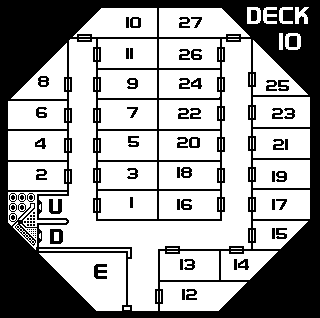
Deck Ten is devoted to still more crew's quarters. The engineering crew and maintenance crew live on this deck so they can be near their shops. There are several empty cabins on this level that can be used for extra passengers.
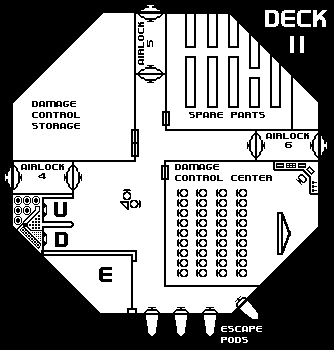
Deck Eleven is called the Damage Control deck. The deck is divided into three usable sections. One is used for storing extra hull plates, while the second is for various spare parts for the engines, astrogation gear, and other parts not stored elsewhere.
The final section is the battle station for all crew whose mission is not considered vital during combat. These crew, like the ships' cooks and scientists, join several engineers in this room, where they will help out in repairing damage. All of these crew are trained in the use of Plastiseal and collapsible hull braces, and are trained in welding, fire fighting, and swapping out damaged circuitry. They are lead by two engineers that brief them on the tougher jobs using a large holovid screen at the front of this room. All are equipped with spacesuit anchors and magnetic shoes in case they are outside the hull on repair jobs during high-G maneuvers.
To aid in getting to the damaged hull section from the outside, this deck has three main airlocks. Lastly, there are four more escape pods on this level.
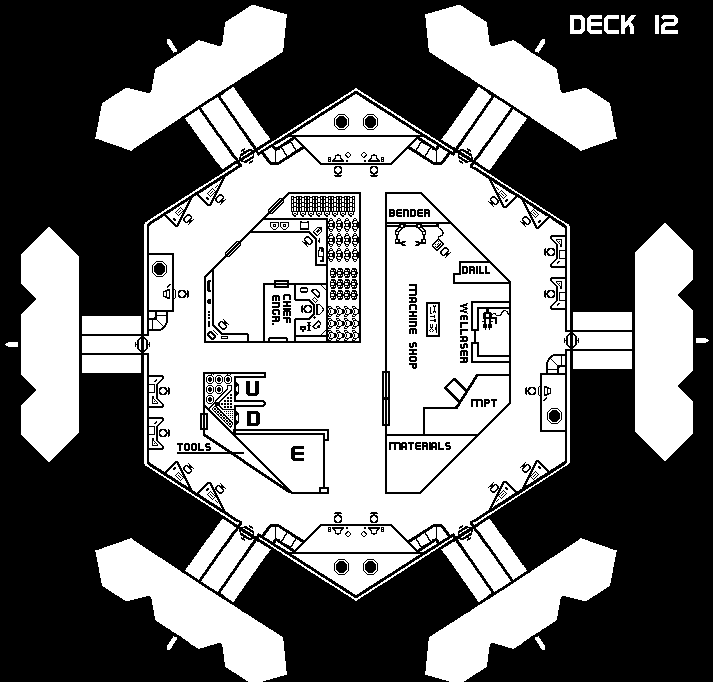
The final deck is, of course Deck Twelve, Main Engineering. The Chief Engineer of the Challenger has his office here, as well as the workstations of all of the assistant engineers.
The machine shop located here has a powerful robotic bending machine used to curve extra hull plates to the shape of the hull, an extra powerful portable Wellaser, a main power torch for heating up large deck plates before bending, a cutting tool, and an industrial strength drill. Using these tools, any hull plate or replacement part can be manufactured. The engineers' INS suits, used during overhauls and engine damage repair, are kept in a locker on this level as well.
Mounted outside the hull here are the six massive Class-C atomic fission drives. Built by Rand Interstellar, these are the same engines as are mounted on the newest spacefleet battleships and, due to them, the Challenger can both accelerate and turn at two-G's. This makes the Challenger just as fast and twice as maneuverable as any previous heavy cruiser, both Sathar and UPF.
These drives are mounted on struts to keep them away from the hull so that radiation levels in Engineering can be kept to normal levels. These struts have explosive charges mounted in them so that if a drive starts to reach meltdown or overload, they can be jettisoned. The engines would travel at about 100 meters per minute after being jettisoned. The Challenger can accelerate and turn at one-G with only three engines functioning, but this doesn't improve much until all six engines are on line. These engines are sturdy enough to make a dozen interstellar jumps between overhauls, which was considered a necessity given the Challenger'smission.